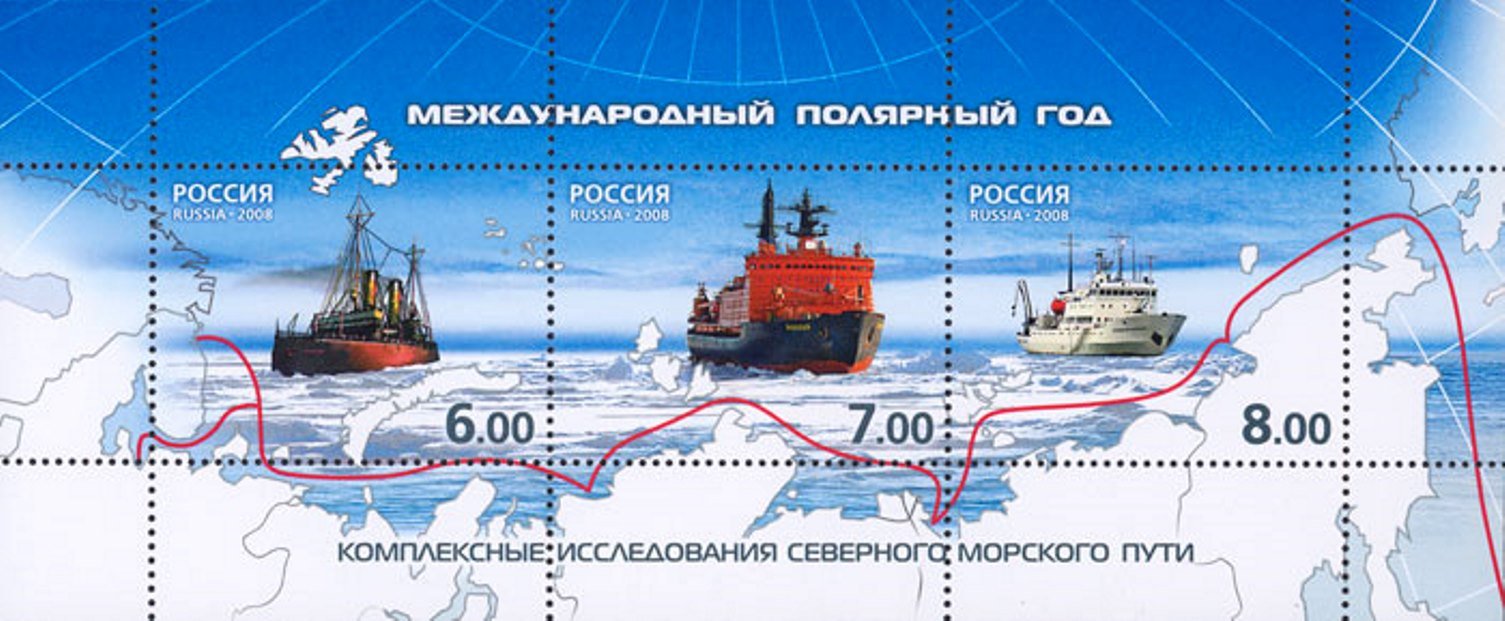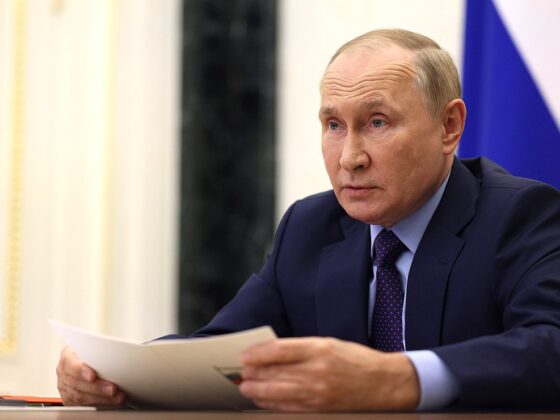Even before Soviet times, Russian icebreakers were considered one of the country’s main strengths in the Arctic. As Vice Admiral Stepan Makarov put it over a century ago in 1897, “No nation is interested in icebreakers as much as Russia.” However, Russia’s invasion of Ukraine has affected its economic and military projects in the High North, where, not long ago, the Kremlin was touting the benefits of increased North Sea Route (NSR) trade due to melting Arctic ice. European and U.S. sanctions have stalled the acquisition of key marine and shipbuilding components. Moscow had been endeavoring to diversify energy exports, with emphasis on sending Siberian LNG to Asia, but now large, new LNG extraction and LNG transportation projects are on hold. Important climate science projects with Russia, such as tracking permafrost, have stopped, alongside EU funds for any scientific collaboration.
Russia’s application of deep resources toward its Ukrainian war while under sanctions and with a deteriorating economy has diminished its Arctic undertakings and its northern fleet’s capabilities and prospects. For the most part, the fleet has always been envisaged as dual-use—civilian/economic and military—which may help it weather its current operational and boatbuilding problems. Even so, the outlook is grim, as Moscow policymakers focus on the war and its associated domestic and international tribulations.
The Icebreaker Fleet
Russia’s state and non-state-owned universal (multi-purpose) icebreaker fleets consist of more than 40 vessels, including nuclear, diesel-electric, and diesel-powered icebreakers. The majority of these ships were built during the USSR period and have operational problems.
Rosatom, the state nuclear energy corporation, has a small nuclear-powered fleet of icebreakers and manages non-nuclear-powered service and container vessels and ice-class tugboats, and port icebreakers. The advantage of using nuclear icebreakers is that, unlike regular (diesel) icebreakers, they can operate for extended periods without refueling. Some have remained at sea for nearly 400 days. However, because of their high maintenance and operational costs, Russia’s nuclear fleet has operated at a loss—but planners had expected profitability to improve from cargo volumes along the NSR. Experts predict that the route could see cargo volumes of up to 80 million tons a year by 2030.
The building of new nuclear-powered icebreakers is ongoing. Several ships—Arktika, Sibir, Ural, Yakutia, and Chukotka—are under construction. In the eastern region, their capabilities will be limited to the summer-autumn period. Another ship being built is the universal Lider, which is poised to be able to function in the NSR year-round from 2027. Most of Russia’s diesel-electric icebreakers were built during the Soviet Union and are operated by the Ministry of Transport (Rosmorport). The Lena United River Shipping Company owns several vessels, and Norilsk Nickel has had its own Arctic fleet since 2006. Both state and private companies involved in the exploration of natural resources in the Arctic were actively developing icebreaker capabilities or investing in Rosatom’s boatbuilding projects. For instance, in 2018 and 2019, the Vilkitsky and Sannikov diesel-electric multi-operational icebreakers began service escorting oil shipments from Gazprom Neft’s Arctic projects.
Defense and Combat Roles
The Russian Ministry of Defense has six military bases in the High North: on the Kotelny Islands (Novosibirsk Islands), Alexandra Land (part of the Franz Josef Land archipelago), Sredniy (Severnaya Zemlya), as well as in the village of Rogachevo (Novaya Zemlya) on Cape Schmidt, and Wrangel Island (part of the Chukotka Autonomous Okrug). In addition, there are more than a dozen military airfields, anti-aircraft missile systems, and small ports. The overall strategy is to protect the territory from a possible attack from the north while also controlling gates of access. Icebreakers can prohibit the unauthorized passage of foreign (war)ships and deliver equipment and goods to outposts and garrisons.
The first Russian combat icebreakers appeared in the 1960s. The Dobrynya Nikitich was made at the Admiralty Plant in Leningrad, with thirty subsequently built. From the laying of their keels, dual-use was considered, and they were employed by the navy, border guards, and the Ministry of the Maritime Fleet (Minmorflot). In the late 60s, a combat version appeared, and in 1973 the improved Ivan Susanin was built. Most were dismantled in the 1990s.
In a first since the Soviet era, in 2017, the Ilya Muromets, a multi-purpose patrol icebreaker, was completed and delivered to the Russian Northern Fleet. It is a diesel-electric icebreaker that can function in ice up to 1.5 meters (5 ft) thick. Several more, such as Ivan Papanin, Nikolai Zubov, and Evpatiy Kolovrat, are being built in St. Petersburg. They are meant to be capable of performing battleship, icebreaker, and tugboat tasks and can carry a wide range of systems, including advanced artillery, helicopters, and assault boats. However, according to Izvestia, completion will be postponed primarily due to sanctions. For its part, the Russian Border Guard Service has ordered two multi-purpose patrol icebreakers similar to the Ivan Papanin, with the first one, Ermak, laid down in 2020 in Vyborg, but these are also expected to be delayed. Today, five icebreakers (Yamal, Taimyr, Vaygach, 50 Let Pobedy, and Arktika) overseen by Rosatom’s subsidiary Atomflot are escorting ships along the NSR and providing rescue assistance to the military.
In 2019 a chief designer at the Tactical Missile Armament Corporation said that the Russian Navy had adopted a new “open stern” concept for its northern boats. The idea is to have mission flexibility. For example, the aft of the ship can house containers containing deep-sea robots or Uranus combat robots, or launchers for Kalibr cruise missiles, X-35 anti-ship cruise missiles, and Onyx supersonic cruise missiles.
The Doctrine and Tasks
The main task of the Russian nuclear icebreaker fleet is ensuring the safety of navigation in the Arctic, supporting the navy, providing emergency preparedness, and implementing controls in the interests of national security and the natural environment. Moreover, only Russian icebreakers are authorized to provide service to foreign vessels in case of an emergency, such as thickening or shifting ice. In some cases, official documents reflect cooperation between the military and other institutions. For instance, the 2017 governmental program on northern socioeconomic development referred to the necessity of creating a dual-use transport infrastructure, including in the ports of Dikson, Tiksi, Pevek, and Providence.
The Russian Maritime Doctrine (2022) identifies efforts by a number of states “to weaken the control of the Russian Federation over the Northern Sea Route” as among the main challenges and threats to “national security and sustainable development of the Russian Federation associated with the World Ocean.” It stresses control over foreign military activity on the NSR, the development of which is declared as a main national interest and strategic goal. The document also provides insight into how Moscow might engage in a maritime conflict with the West, including “mobilizing” its civilian fishing fleet, oceanographic vessels, and other non-military vessels and installations to support a potential conflict.
However, goals and missions have been harmed due to long-time bureaucratic struggles and logistical pitfalls. Multiple agencies—Rosatom, Rosatomflot, Atomflot, Rosmorport, Rosmorrechflot, NSR Administration, and Ministry of Transport—have been involved in Russia’s Arctic endeavors, leading to clashes between managers. Last year, a small scandal arose when essential goods and products were not delivered to remote settlements in the Far East. In a streamlining effort, in July 2022, President Vladimir Putin signed a draft bill to transfer control of the NSR to Rosatom. Thus, of the two main agencies, Rosatom is winning the competition over Rosmorport to manage the High North.
The Invasion
Since the beginning of Russia’s invasion of Ukraine, Northern Fleet ground forces have been used in the war. As the High North News reported, Russia has few ground forces left on the Kola Peninsula in the northwest near Finland because they were moved toward Ukraine “despite Russia keeping its nuclear weapons in the North.” The policy suggestion is that the Kremlin sees the situation in the High North as stable.
However, problems and challenges endure. For instance, Valery Timofeev, the Russian vice president of the Russian-Finnish “Helsinki Shipyard Oy” was suddenly arrested in Moscow for treason this past July. The company mostly makes boats for Russia. More recently, Russia terminated its memorandums with the Nordic Council of Ministers, which includes Denmark, Iceland, Norway, Finland, and Sweden, to establish information centers in St. Petersburg and Kaliningrad. Furthermore, this past summer, Finish company Wärtsilä announced it had completed its exit from the Russian market. The company supplies ship engines and parts to Russian shipyards, mainly for icebreakers. Its departure affects current builds, such as that of the Yakutia and Chukotka. Instead of importing rudders and propellers, Russian-made equipment is now planned to be used, including Transmashholding’s diesel engines.
Russia had lofty plans to build more icebreakers and support ships, both nuclear and non-nuclear, with intended completions in 2027, 2030, and 2035, but sanctions limit progress. For example, Nornickel and Rosneft decided not to pursue plans to build LNG-powered vessels because of sanctions. “Preliminary, we looked at the opportunity to build icebreakers fueled with LNG, but considering the sanctions and the companies’ revision of plans, both Nornickel and Rosneft confirm that they [instead] are interested in building diesel icebreakers,” said the Deputy Head of Rosatom’s Northern Sea Route Directorate Maksim Kulinko. Against this restrictive backdrop, however, Kommersant recently reported that Rosatom obtained financing for the development of the eastern NSR.
Because of the invasion, Norilsk Nickel and Rosatom decided not to build liquefied natural gas (LNG) fuel system vessels, which had been a promising development because of deep reserves, and opted instead to build diesel-electric icebreakers. One reason the company was keen to use LNG-powered vessels is that it was responsible for “the worst Russian environmental disaster” in the north when 21,000 tonnes of its diesel leaked into rivers and subsoil in 2020.
Conclusion
Russia’s Arctic plans have been shaken at a time when it was attempting to re-organize the coordination of commercial, civilian, and navy activities along its NSR. The invasion of Ukraine slowed or ended its northern ventures, as human and material resources went south, while sanctions halted the purchasing of key components. The lack of investment and technology degrades energy extraction projects and the development of the NSR, which needs new capable ice-class ships. If anything, Russia’s economic difficulties and boatbuilding delays will enhance the dual-use capabilities of old and new Russian icebreakers in the coming years.
Nurlan Aliyev is Lecturer at the University of Economics and Human Sciences in Warsaw. (Twitter: @anurlan)











